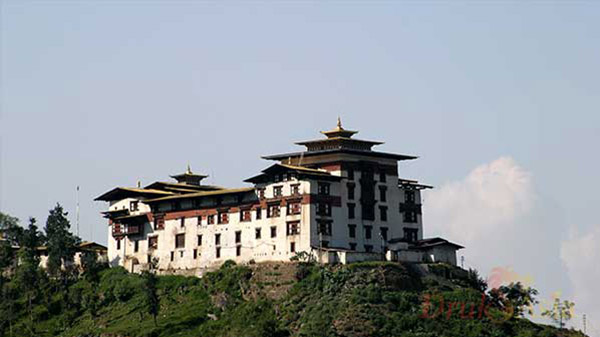18 Days Merak Sakteng Bhutan Trek Itinerary covers Bhutan East to West. It also includes a trek into the most untouched part of Bhutan.
Itinerary
Bhutan has introduced its domestic flights between Paro, Bumthang and Yonphula (Trashigang). You can reduce the duration of the trek to 15 days if you use the domestic flight to Trashigang from Paro International Airport.
Regional Background
Situated at an altitude over 3,500 meters, the exotic valleys of Merak and Sakten have been home to the Brokpas for centuries since their displacement from Tsona in southern Tibet. The nomadic indigenous group of eastern Bhutan, the Brokpas seasonally move their herds of livestock from the lower valleys in the winter to the higher pastures in the summer. While polygamy is a prevailing practice as well, marriage among Brokpa couples is a convergence of practical consideration and sacred responsibility, with elaborate rituals to seal the union. Like the rest of Bhutan, they are fond of archery and are skilled in the games of accuracy. Women are particularly well known for their singing and they love to perform from their wide range of repertoire of festive songs dedicated to gods and goddesses, as well as the universal themes of nature, youth and old age.
Brokpas prefer to wear their traditional attire spun from yak hair. Traditional wear for men comprise a black hat with five long fringes hanging from the sides. The upper part of their body is covered by a thick jacket with a vest of animal hide tied at the waist by a long belt known as a kera. For the lower part of the body, traditional fashion dictates a knee length pair of shorts called kongo. Women usually wear their long hair tied up in plaits with colourful ribbons. An apron reaching to their knees is tied at the waist. Woven out of raw silk, the women’s dress is designed with colourful motifs of animals and flowers. Fond of jewellery, they wear long strands of corals, cat’s eyes and necklaces of semi-precious stones.
Things to see and do
The diverse rituals and customs of the Brokpa people make Merak and Sakten an interesting place to visit, especially each Autumn when they honour their mountain goddess Jomo Kuengkhar by observing a two-day festival to seek her blessings for prosperity. The festival is also an occasion to witness the annual naked terchham dances of the Brokpas and the cultural splendour of the Ache Lhamo dances performed by herders annually to honour another feminine divinity sacred to their people.
There are several interesting temples and monasteries in both valleys: the Borangtse Lhakhang, the Guru Goemba and Labrang Lhakhang. At the Gango Tashi Choling temple in Merak, established in the 15th century, it is possible to see th remains of its founder. In the Samtencholing Lhakhang it is possible to view that what is purportedly the ancient saddle and the phallus of goddess Jomo’s horse. The Sakteng wildlife sanctuary is spread over 650 sq. kilometres and is the only reserve in the world dedicated to protecting the habitat of the yeti or abominable snow man. The sanctuary is mountainous and rugged and boasts a diverse variety of flora and fauna. Populations of snow leopard, red panda, Himalayan black bear, barking deer and the Himalayan red fox have been recorded in the region. The park also has rare blue poppies, Bhutan’s national flower. Primulas and gentiana that explode in a riot of colors in the spring. The avian population of the park includes hoary-bellied Himalayan squirrel, Assamese macaw, blood pheasant, grey backed shrike, grey-headed woodpecker, the common hoopoe, rufous-vented tit and dark breasted rose finch.
Day 1: Arrival in Paro, Bhutan
Welcome to Bhutan, the Land of the Thunder Dragon. Touching down at Paro International Airport, you will be greeted by your guide upon exiting the arrival hall. Today, we will take it easy to acclimatise to the altitude. Drive to Thimphu, check in to the hotel and lets have your first taste of Bhutanese cuisine and some light sight-seeing in Thimphu if possible.
Viewpoints around Thimphu
National Memorial Chorten – Which was built in honor of the late King Jigme Dorji Wangchuk.
Buddha Point at Kuensel Phodrang, will be open to tourists once it is completed in 2012. The 169 feet bronze statue of Buddha Dordenma , Vajra Throne Buddha symbolising indestructibility will be completed soon. The Buddha statue itself is competed awaiting paintings, but visitors can drive up to the Buddha point and view the tallest statue of Lord Buddha. The view of Thimphu valley from the Buddha point is spectacular and beautiful, especially at night.
Hotels:
 Jumolhari Hotel |
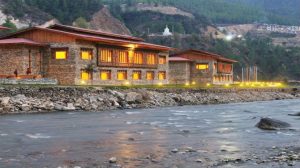 Terma Linca Resort |
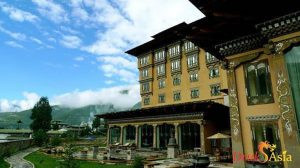 Taj Tashi Thimphu |
Day 2: Thimphu
Heritage Museum – Dedicated to connecting people to the Bhutanese rural past though exhibition of artefacts used in rural households.
Textile Museum – witnesses the art of traditional weaving.
Thimphu Dzong – the largest Dzong, is also the seat of the office of the King of Bhutan.
Paper making factory – witnesses the art of paper making.
Simtokha Dzong – Five miles from Thimphu, on a lofty ridge, stands Semtokha Dzong the oldest fortress in the Kingdom.
Centenary Farmers’ Market – Every Saturday and Sunday most of the Thimphu population congregate on the banks of the river where the weekend market is held. Here villagers from the valley and other nearby places come to sell their agriculture products.
Hotels:
 Jumolhari Hotel |
 Terma Linca Resort |
 Taj Tashi Thimphu |
Day 3: Thimphu to Gangtey
Dochula Pass – The 108 chortens was built by the present Queen Mother of Bhutan Ashi Dorji Wangmo Wangchuck to commemorate Bhutan’s victory over Indian militants and to liberate the souls of the soldiers lost.
Passing Wangdue (left), one of the major towns and district capital of Western Bhutan. Located south of Punakha, Wangdue is the last town before central Bhutan. The district is famous for its fine bamboo work and its slate and stone carving.
We will pause to view the Wangdue Phodrang Dzong. Built in 1638, Wangdue Dzong is dramatically perched on the spur of a hill and overlooks the confluence of the Tsang Chu and Dang Chu rivers.
Hotels:
 Homestay |
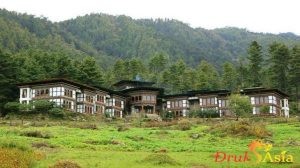 Dewachen |
Day 4: Gangtey
The valley of Phobjikha is well known as the winter home of the Black necked crane (Grus Nigricollis). Bhutan is home to around six hundred black-necked cranes with Phobjikha being one of the popular places that the birds migrate to in the winter months from the Tibetan plateau. The elegant and shy birds can be observed from early November to end of March. This is an old monastery that dates back to 17th century. Today we will do some short hikes around the valley of Phobjikha.
Hotels:
 Homestay |
 Dewachen |
Day 5: Gangtey to Bumthang
Trongsa, literally “New Town” in the Dzongkha language, is where the current monarchy had its origin in Bhutan. Each King in the line of succession has held the post of Trongsa Penlop or Governor before donning the Raven Crown.
Trongsa Dzong – The foundations of Trongsa Dzong were laid in the 16th century by by Pema Lingpa. The Dzong flourished during the 17th century under Shabdrung Ngawang Namgyal. With its massive structure, its wall looming high above the winding Mangde Chu Valley, the Dzong commands the east-west road.
Hotels:
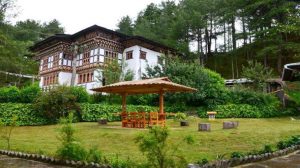 Rinchen Ling Resort |
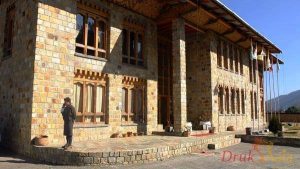 Wangdichholing Resort |
 Peling Hotel |
Day 6: Bumthang
This is one of the most spectacular valleys in Bhutan and also the heartland of Buddhism in Bhutan. It is an area with a wide variety of fauna and flora. The Guru Rinpoche and his lineage of Tertons (treasure finders) making Bumthang his home have led to more than 40 temples being built in this peaceful valley.
In the morning, we will hike to the Tamshing Goemba, built in 1501 by the Buddhist saint Pema Lingpa. We will also visit Kurjey Lhakhang (left-bottom), one of the most sacred monasteries in Bhutan. Built by the Guru Rinpoche in 1652, it houses a rock with his body imprint. Legend has it that Guru Rimpoche manifested as a Garuda to defeat the demon Shelging Karpo who had taken the form of a white lion.
We will also visitJambay Lhakhang, built in 659 by Tibetan King Sontsen Gampo to pin down a demons who was obstructing the spread of Buddhism. Come October, the Jambay Lhakhang Drup is one of the most colourful festivals in Bhutan.
Jakar Dzong – pitched on a high ground overlooking the town junction, it was built as monastery in 1549 by the great grandfather of the Zhabdrung. It is now used as the administrative center for Bumthang district In the afternoon, we will hike up to Thangbi Valley, crossing a suspension bridge to visit the Thangbi Lhakhang built in the 14th century via an unpaved road.
Hotels:
 Rinchen Ling Resort |
 Wangdichholing Resort |
 Peling Hotel |
Day 7: Bumthang to Trashigang
On route to Trashigang from Bumthang is the biggest national park in Bhutan called the Thrumshingla National Park. The 768 sq.km of this national park is located within the boundaries of four districts: Bumthang, Lhuentse, Mongar and Zhemgang and it was established in 1998.
On this long drive, enjoy the natural beauty of the undisturbed environment and take pics of some breath taking scenery like the Namling Bra (cliff) waterfall which falls down the deepest cliff in Eastern Bhutan.
Day 8: Radi to Charbaling
Drive from Trashigang to Radi and Khardung villages and the starting point. It is a steady climb today on a slippery foot path through forest, occasionally along the Murbi Chhu, finishing in 3-4hr at Charbaling winter grazing grounds.
Day 9: Charbaling to Merak
A 2 hour climb to Thumburtsa La (3273m) from Charbaling from where another 3-4 hour of easy hiking leads to Merak Village via Gengou.
Day 10: Merak to Sakteng
You can choose to stay in Merak for a day or two. There are lots to see like the villages and lakes. If not, keep going from Merak to Sakteng including crossing the Nyuksang La (4,140 m). A steady climb of 2-2.5 hour leads to the pass, from where a steep 3 hour descent with 1 hour along a river gains Sakteng. At the end of the day, a steep climb of 1 hour leads to a chorten form where it is 30 mins down to Sakteng located in a big open space surrounded by heavily forested mountains.
Day 11: Sakteng
It’s worth spending an extra day in Sakteng to explore. Sakteng had about 60 houses in the past and the village has grown a little over time. The inhabitants are very religious and north and east of Sakteng -in India – are many important Buddhist temples.
Day 12: Sakteng to Jyonkhar
Carry on to Jyonkhar crossing a small pass, Munde la (2,928 m). There are a couple of small ups and downs before reaching Jyonkhar after 5-6 hour.
Day 13: Jyonkhar to Phongme
Jyonkhar to Phongme in 2.5-3 hour, including one stiff climb of 1 hour before reaching Phongme.
Day 14: Trashigang to Bumthang
Long drive back to Bumthang. Have a nice rest in your vehicle while enjoying the scenery
Hotels:
 Rinchen Ling Resort |
 Wangdichholing Resort |
 Peling Hotel |
Day 15: Bumthang to Punakha
We drive to Punakha a much warmer valley with its own beautiful characters and many stories of its own
Hotels:
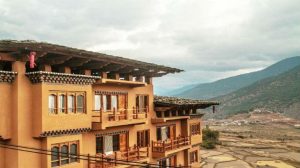 Hotel Lobesa |
 Meri Puensum |
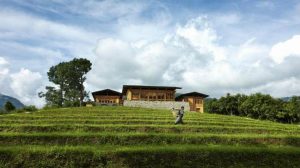 Uma Punakha |
Day 16: Punakha to Paro
Punakha Dzong – Built in 1637, the dzong continues to be the winter home for the clergy, headed by the Chief Abbott, the Je Khenpo. It is a stunning example of Bhutanese architecture, sitting at the fork of two rivers, portraying the image of a medieval city from a distance. The dzong was destroyed by fire and glacial floods over the years but has been carefully restored and is today, a fine example of Bhutanese craftsmanship.
Chhimi Lhakhang – A 20 minutes walk across terraced fields through the village of Sopsokha from the roadside to the small temple located on a hillock in the centre of the valley below Metshina. Ngawang Chogyel built the temple in 15th century after the ’divine Madman’ Drukpa Kuenlay built a small chorten there. It is a pilgrim site for barren women.
Khamsum Yulley Namgyal Chorten – Built by the third Queen Mother Ashi Tshering Yangdon wangchuck this Chorten is a splendid example of of the Bhutanese architecture and art and is the only one of its kind in the world. It has been built over eight and a half years and its details have been drawn from religious scripture.
Hotels:
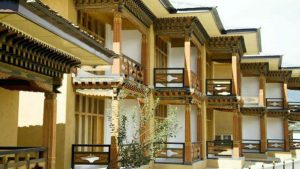 Tenzinling Resort |
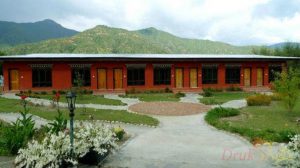 Metta Resort & Spa |
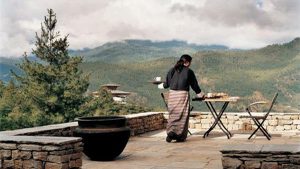 Uma Paro |
Day 17: Paro
Paro Valley – The beautiful valley is home to many of Bhutan’s old monasteries and temples. The country’s only Airport is in Paro. The valley is also home to mount Chomolhari (7,300 meters) situated at the northern end of the valley whose glacier water forms the Pachu flowing through the valley. The following are some of the prominent places to visit in Paro.
Paro Dzong – also known as Rinpung Dzong, this 15th century massive fortress/monastery, is also the administrative center of the dzonkhag
Taktsang Monastery – A one hour hike to the cafeteria is also a vantage view whereby you can enjoy the stunning view of the monastery. Prayer flags adorn the cliff and this is also where Guru Padmasambhava landed on the back of a tigress in the 8th century.
Kyichu Lhakhang – After a sumptuous local lunch, we will retrace our steps to visit Kyichu Lhakhang, one of the oldest temples in Bhutan.
Hotels:
 Tenzinling Resort |
 Metta Resort & Spa |
 Uma Paro |
Day 18: Depart Paro
Today we will bid fond farewell to this beautiful Himalayan country and take an early flight back to Singapore. We hope by now you would have made some friends and also kept many photos and beautiful memories of Bhutan! And we look forward to seeing you again in this beautiful land of endless Enchantments! Tashi Delek!
What’s Included
» Private guided tour
» Visas for Bhutan
» Airport transfers
» Daily 3 meals (B/L/D) at designated restaurants or hotels
» Accommodation at 3 star hotel
» A qualified & licensed English-speaking guide
» An experienced driver
» A tour vehicle
» Entry fees & road permits
» Government fee, royalty, taxes & surcharges
» Mineral bottled water
» Set of traditional costume (to be return at the end of your stay)
» Full service & assistance before, during and after your Bhutan trip
Trekking equipment provided:
» A Cook
» Camp assistances
» Horses
» Sleeping bag
» Sleeping mats
» Blankets
» Tents
Suitable Months
March to April and September to November
Prices
For Travel during the months of: Mar-Apr and Sep-Nov
USD 4,979 for 1 person traveler
USD 4,809 per person for 2 person travelers
USD 4,299 per person for group of 3 and above
What’s Excluded
» Flight into Bhutan via Drukair (can be arranged with us)
» Flight on other airline to catch Drukair Flight
» Hotel stay outside of Bhutan
» Travel Insurance (can be arranged with us)
» Meals at 4-5 stars restaurants
» Tips for the guide and driver
» Alcoholic drink
» Expenditure of personal nature
Our Guarantee
Guaranteed Visa approval. We have yet to disappoint a single of our travellers in term of Visa issuance.
Your choice of hotels will be confirmed for your inspection before your arrival. We only book you on hotels which we love and would love again.
We will be happy to change your guide, driver or vehicle on the first two days of arrival in Thimphu if you are not satisfied with our selection. Drop us a note and our hospitality team be on the spot to assist you.
We’re here to help. Our world-class member services team is available by phone or email — there’s no automated system or call center; you’ll communicate with a real person.

